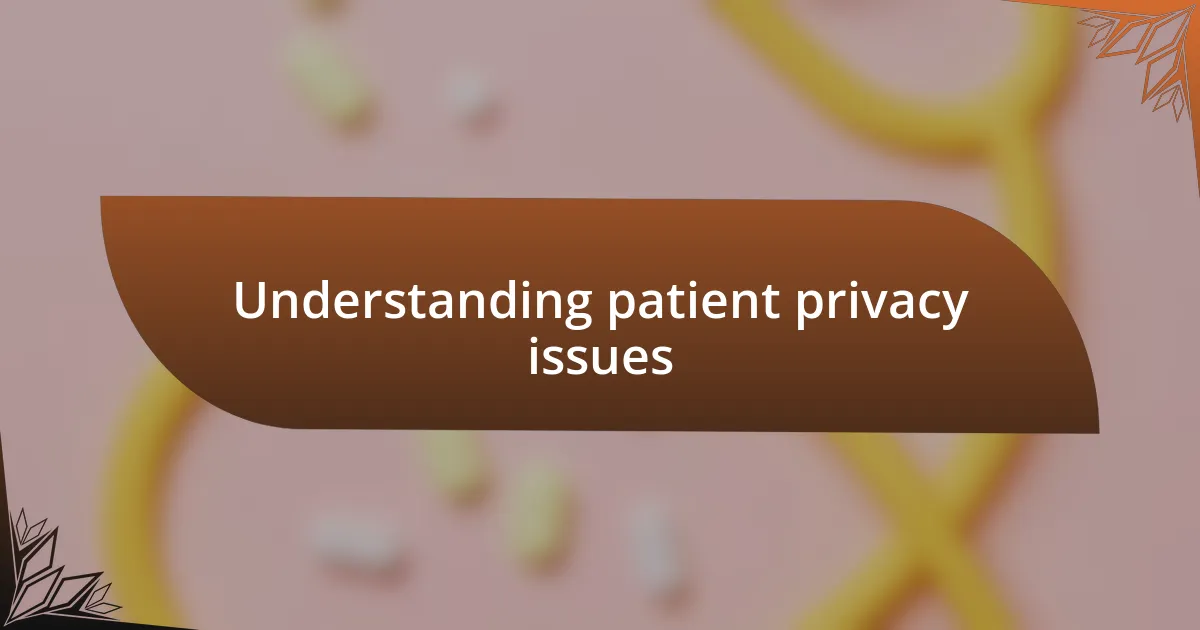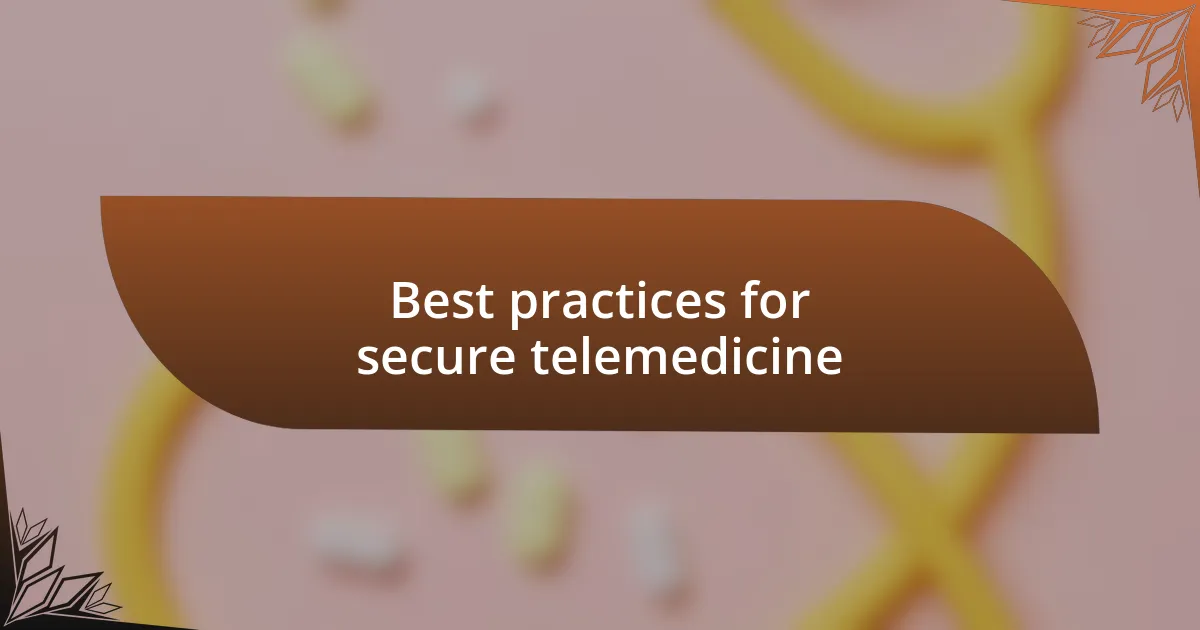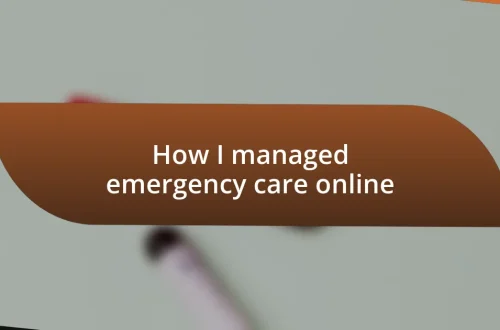
My insights on patient privacy in telemedicine
Key takeaways:
- Data breaches pose significant risks to patient privacy, highlighting the need for vigilance in protecting personal health information.
- Legal frameworks like HIPAA and GDPR establish essential protections for patient data, emphasizing consent and rights over personal information.
- Best practices for secure telemedicine include using encrypted communication, regular software updates, and staff training in security protocols.
- Patient consent is crucial in telemedicine, as it builds trust and empowers patients regarding their personal health information management.

Understanding patient privacy issues
Navigating the landscape of patient privacy in telemedicine can feel overwhelming. I remember my first experience with a virtual consultation; I was anxious about whether my personal information would be secure. It made me wonder—how often do people truly consider the implications of sharing sensitive health data online?
One major issue is the risk of data breaches, which can lead to personal health information being exposed to unauthorized parties. This reality hit home when a colleague of mine shared their distressing story about their data being compromised. It really made me think—are we as vigilant as we should be when it comes to protecting our information in the digital sphere?
Additionally, the ambiguity around consent can create confusion for patients. During my own virtual visits, I’ve often pondered whether I fully understood what I was agreeing to when sharing my data. This understanding is critical; if patients don’t grasp the nuances of consent, how can they feel secure in their privacy?

Legal frameworks protecting patient data
Legal frameworks designed to protect patient data in telemedicine are essential for establishing trust and ensuring privacy. I recall a time when I first learned about HIPAA (Health Insurance Portability and Accountability Act). The stringent rules surrounding the handling of personal health information made me feel reassured, knowing there are legal consequences for any mishandling of data.
Understanding the specifics of these regulations is crucial. For instance, the General Data Protection Regulation (GDPR) emphasizes patient consent and data protection rights, offering patients significant control over their personal information. When I encountered situations where my consent was sought for data usage, I realized just how powerful this framework was in empowering me as a patient, making my voice heard and understood in a system that can often be overwhelming.
Moreover, various states in the U.S. may have additional laws that align with or even expand upon federal regulations. This patchwork of laws can create challenges but also emphasizes the importance of compliance for health care providers. I often reflect on my conversations with healthcare professionals who acknowledge the difficulty in navigating these diverse regulations, yet they remain committed to safeguarding patient data as a core principle of their practice.
| Legal Framework | Key Features |
|---|---|
| HIPAA | Protects patient health information, establishes confidentiality and security rules. |
| GDPR | Focuses on patient consent, data protection rights, and the right to be forgotten. |
| State Laws | May have additional protections, creating a more complex regulatory environment. |

Best practices for secure telemedicine
Ensuring secure telemedicine requires a combination of technology, policies, and awareness. From my experience, I’ve seen how simple practices can drastically reduce risks. For instance, using strong, unique passwords and implementing two-factor authentication are foundational steps that help safeguard patient information. These measures may seem basic, but they create a significant barrier against unauthorized access.
Here are some best practices to enhance security in telemedicine:
- Utilize encrypted communication tools that protect data in transit.
- Regularly update software and applications to patch any vulnerabilities.
- Conduct thorough training for staff on security protocols and data handling.
- Limit access to patient data based on necessity and role.
- Regularly review security policies and protocols to ensure compliance with legal standards.
In my interactions with healthcare providers, I’ve often noticed that their awareness of these practices is not just a matter of compliance; it’s about creating a culture of security. When they actively engage in these practices, it greatly reassures me as a patient. I remember discussing data protection with a nurse who stressed the importance of these measures, sharing how it made her feel more connected to the patients she served. Knowing that the people tasked with my care are diligent about privacy creates a sense of trust that is hard to quantify but deeply felt.

Ensuring confidentiality in virtual consultations
When it comes to virtual consultations, confidentiality hinges on the technology used. I’ve personally found that utilizing platforms with end-to-end encryption can significantly enhance the security of sensitive discussions. If I know that my conversation is protected from eavesdropping, it allows me to speak more freely, which is crucial for effective healthcare.
Another critical aspect is being aware of the environment during consultations. I recall a time when I had a virtual appointment while sitting in a busy café. The healthcare provider gently reminded me to find a quieter location next time. This simple advice helped me realize how important the setting is; it’s not just about the technology but also about ensuring conversations remain private. What would you do if someone overheard your health concerns?
Lastly, staff training in confidentiality practices is essential. I remember attending a workshop where the importance of discussing privacy protocols was emphasized. The trainer shared a story of a colleague who inadvertently shared patient information due to a lapse in attention. This story stuck with me, highlighting how easy it is for confidentiality breaches to occur. It left me with a sense of urgency: we must all be vigilant, as our collective efforts protect the privacy of all patients in the virtual space.

Patient consent and data sharing
Patient consent in telemedicine is foundational, as it directly relates to how patient data is handled. I once participated in a telehealth session where my provider took the time to explain the consent process in detail. This clarity made me feel secure knowing exactly what would happen with my information; it was a reassuring moment that emphasized the value placed on my privacy.
Moreover, discussing data sharing during these consultations is crucial. There was an instance when I learned that certain health apps require explicit consent to share data with third parties. It made me wonder: how many patients are truly aware of where their information goes? This awareness isn’t just about legal requirements; it’s about fostering trust between patients and providers.
Navigating these waters, I often consider the balance between convenience and privacy. I recall a time when I hesitated to share my medical history digitally, fearing it could be misused. It’s a reminder that while technology offers great benefits, patient consent should always be prioritized to ensure we are in control of our personal health information.




